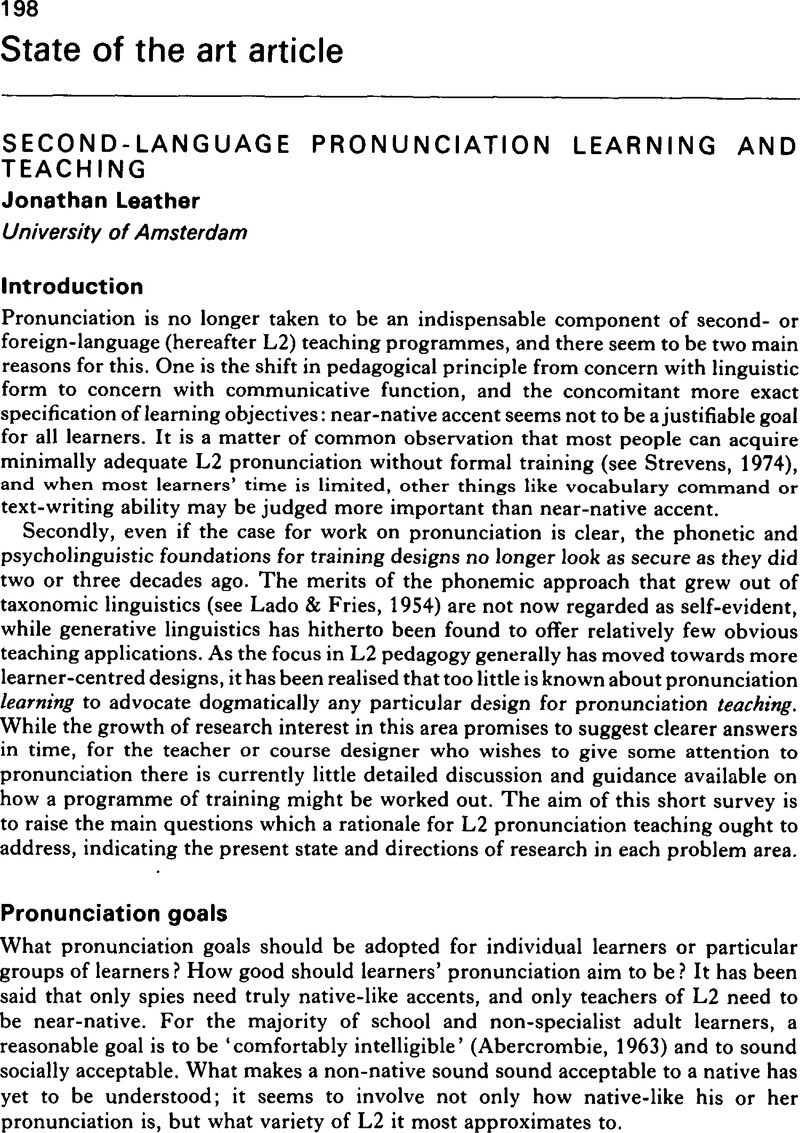Crossref Citations
This article has been cited by the following publications. This list is generated based on data provided by Crossref.
Dirven, René
and
Oakeshott-Taylor, John
1985.
Listening comprehension (Part II).
Language Teaching,
Vol. 18,
Issue. 1,
p.
2.
Yule, George
Damico, Jack
and
Hoffman, Paul
1987.
Learners in Transition: Evidence from the Interaction of Accuracy and Self‐Monitoring Skill in a Listening Task.
Language Learning,
Vol. 37,
Issue. 4,
p.
511.
Flege, James Emil
1988.
Using Visual Information to Train Foreign‐Language Vowel Production*.
Language Learning,
Vol. 38,
Issue. 3,
p.
365.
Taylor, David S.
1991.
Who speaks english to whom? The question of teaching english pronunciation for global communication.
System,
Vol. 19,
Issue. 4,
p.
425.
Leather, Jonathan
and
James, Allan
1991.
The Acquisition of Second Language Speech.
Studies in Second Language Acquisition,
Vol. 13,
Issue. 3,
p.
305.
Garrett, Peter
1992.
Accommodation and hyperaccommodation in foreign language learners: Contrasting responses to French and Spanish english speakers by native and non-native recipients.
Language & Communication,
Vol. 12,
Issue. 3-4,
p.
295.
Trammell, Robert L.
1993.
English Ambisyllabic Consonants and Half‐Closed Syllables in Language Teaching.
Language Learning,
Vol. 43,
Issue. 2,
p.
195.
Harley, Birgit
Howard, Joan
and
Hart, Doug
1995.
Second Language Processing at Different Ages: Do Younger Learners Pay More Attention to Prosodic Cues to Sentence Structure?.
Language Learning,
Vol. 45,
Issue. 1,
p.
43.
Leather, Jonathan
and
James, Allan
1996.
Handbook of Second Language Acquisition.
p.
269.
Leather, Jonathan
and
James, Allan
1997.
Second-Language Speech.
p.
1.
Bohn, Ocke Schwen
and
Flege, James Emil
1997.
Second-Language Speech.
p.
53.
van Wijngaarden, Sander J.
Steeneken, Herman J. M.
and
Houtgast, Tammo
2002.
Quantifying the intelligibility of speech in noise for non-native talkers.
The Journal of the Acoustical Society of America,
Vol. 112,
Issue. 6,
p.
3004.
Schmidt, Anna Marie
and
Sullivan, Shannon
2003.
Clinical Training in Foreign Accent Modification: A National Survey.
Contemporary Issues in Communication Science and Disorders,
Vol. 30,
Issue. Fall,
p.
127.
김보람
2009.
Examining the Effects of Self-Evaluation in an EFL Pronunciation Class.
English Language Teaching,
Vol. 21,
Issue. 3,
p.
45.
Chun, Dorothy M.
2012.
The Encyclopedia of Applied Linguistics.
Fernández, Juana Gil
2012.
L'enseignement de la prononciation : rapport entre théorie et pratique.
Revue française de linguistique appliquée,
Vol. Vol. XVII,
Issue. 1,
p.
67.
Fernández, Juana Gil
2012.
L'enseignement de la prononciation : rapport entre théorie et pratique.
Revue française de linguistique appliquée,
Vol. Vol. XVII,
Issue. 1,
p.
67.
Hong, Hyejin
Kim, Sunhee
and
Chung, Minhwa
2014.
A corpus-based analysis of English segments produced by Korean learners.
Journal of Phonetics,
Vol. 46,
Issue. ,
p.
52.
Jin, Su-Hyun
and
Liu, Chang
2014.
Intelligibility of American English Vowels and Consonants Spoken by International Students in the United States.
Journal of Speech, Language, and Hearing Research,
Vol. 57,
Issue. 2,
p.
583.
Murphy, John M.
and
Baker, Amanda A.
2015.
The Handbook of English Pronunciation.
p.
36.





